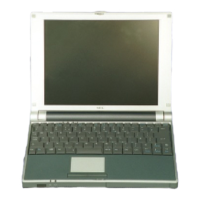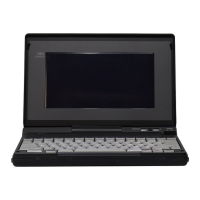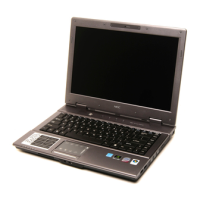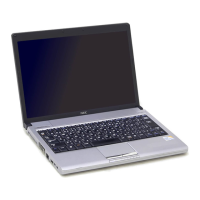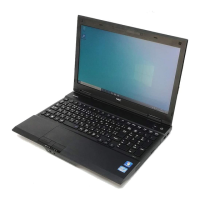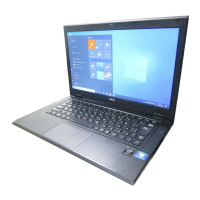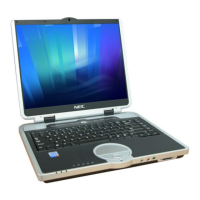Do you have a question about the NEC Versa LX and is the answer not in the manual?
Explains the formatting conventions used in the guide for warnings, cautions, and notes.
Lists other documents providing additional information on the NEC Versa notebook computer.
Guide to understanding the basic setup and features of the NEC Versa notebook.
Details the features and capabilities of the NEC Versa LX notebook computer.
Describes the components and features located on the front of the system.
Details the NEC Versa LX notebook's LCD panel specifications and adjustments.
Explains the indicators and features of the NEC Versa status panel.
Describes the keyboard, VersaGlide, speakers, and power status LEDs.
Details the ports and connectors located on the back of the NEC Versa system.
Describes the ports and features on the left side of the NEC Versa notebook.
Details the ports and features located on the right side of the NEC Versa notebook.
Explains the features found on the bottom of the NEC Versa notebook.
Explains the different power sources available for the NEC Versa notebook.
Instructions on how to connect and use the AC adapter for power.
Steps to power on the NEC Versa notebook computer.
Information on installing, removing, and managing the main battery pack.
How to check the battery power level using the LEDs and software.
Identifies symptoms indicating the battery life is nearing its end.
Guidelines for safely handling and replacing the battery pack.
Important warnings and precautions for handling and recharging batteries.
Guidelines for maintaining the condition and performance of the NEC Versa.
General precautions for using the computer, AC adapter, and VersaBay III.
Recommended environmental conditions for storing the computer and adapter.
Instructions on how to clean the system's LCD screen and case.
Overview of the operating systems and initial software setup.
Tips and information for taking the NEC Versa notebook on the road.
Information on connecting the system to various power sources worldwide.
Essential steps to take before leaving home for travel with the NEC Versa.
Guide to accessing and configuring BIOS settings for the NEC Versa LX.
Instructions on navigating and using the BIOS setup utility screens and keys.
Details on various BIOS setup parameters and their default/alternate settings.
Explanations of the items found within the BIOS setup menus.
Configuration options for managing the system's power consumption and saving.
Procedures for updating the NEC Versa system BIOS using a diskette.
Introduction to the Windows operating systems pre-installed on the NEC Versa.
Overview of Windows 98 features, desktop icons, and taskbar icons.
Overview of Windows 95 features and desktop icons.
Overview of Windows NT features and desktop icons.
Information and instructions for installing Service Pack 4 for Windows NT.
Details on NEC-provided utilities for system efficiency and customization.
Instructions on using the NEC Customize utility for system configuration.
Guide to using the HDPREPEZ utility for memory configuration.
Description of the NEC Help Center's features and content.
Information on applications and drivers available on the CD and their installation.
Information on using Partition Magic for hard disk drive partitioning.
Details on the Intel LANDesk Client Manager for system management.
Information on using SystemSoft PowerProfiler for power management.
Details on SystemSoft CardWizard for PC card management.
Information on using Intellisync for PC-to-PC data synchronization.
Description of the McAfee VirusScan software for virus detection.
Overview of Microsoft Internet Explorer for web browsing.
Overview of Netscape Navigator for internet browsing.
Information on Adobe Acrobat Reader for viewing PDF files.
Details on adjusting the LCD panel brightness and backlight.
Explains the keyboard layout, function keys, and special key combinations.
Guide to controlling the cursor and using the VersaGlide touchpad features.
Options for customizing cursor speed, button orientation, and gestures.
Ergonomic tips for using the NEC VersaGlide touchpad effectively.
Locates and describes the NEC Versa File Bay for drives.
Details the SuperDisk drive's capabilities and formatting diskettes.
Instructions on formatting diskettes in the SuperDisk drive, including error resolution.
Describes the VersaBay III and its supported device options.
Information on warm swapping devices in the VersaBay III using the utility.
Step-by-step instructions for safely removing devices from the VersaBay III.
Step-by-step instructions for installing devices into the VersaBay III.
How to add or replace hard disk drives in the VersaBay III for increased storage.
Details the features and operation of the 24X CD-ROM drive.
Instructions for inserting CDs into the CD-ROM drive.
Guidelines for handling and caring for CDs to prevent damage.
How to enable or disable the CD auto play feature in Windows.
Describes the features and capabilities of the DVD-ROM drive.
Overview of PC Card types (II, II Extended, III) and communication cards.
Details the two CardBus slots for PC card installation.
Step-by-step guide for inserting PC cards into the available slots.
Instructions for safely removing PC cards from the system.
Explains the functionality and use of the infrared (IR) port.
Procedures for enabling the IR port in Windows 98/95 and Windows NT systems.
Information on installing optional hard disk drives or memory modules.
Instructions on replacing or adding hard disk drives to the system.
Step-by-step guide for installing or replacing memory modules (SO-DIMMs).
Identifies and explains the functions of the six-position dip switches.
Steps for accessing and changing the system's dip switch settings.
Identifies and explains the functions of the four-position dip switches.
Steps for connecting and using an external monitor with the NEC Versa.
Instructions for connecting parallel and serial printers to the NEC Versa.
Details on connecting parallel devices like printers using appropriate cables.
Instructions for connecting serial devices such as external modems.
Guide to connecting external PS/2 keyboards and mice to the NEC Versa.
Information on connecting an external bar code scanner using a PS/2 connector.
Steps for connecting the NEC Versa to a television via RCA or S-video ports.
Details on connecting microphones, headphones, and external speakers.
Information on connecting USB devices to the NEC Versa notebook.
Overview of the NEC Versa Dock's capabilities for desktop conversion.
Information on the NEC Versa PortBar for extending system connectivity.
Describes the audio capabilities and file format support of the NEC Versa.
Instructions on using the Microsoft Sound Recorder to record audio files.
Steps to configure volume controls for optimal sound recording quality.
How to use the Line-In port for analog audio input and recording.
Recording music and sound effects directly from a CD-ROM drive.
Capturing and recording sounds using the internal or external microphone.
Combining audio data from multiple files using Sound Recorder.
How to play back audio files through speakers or headphones.
Connecting and using headphones with the NEC Versa audio ports.
Adjusting volume for the NEC Versa's built-in stereo speakers.
Details on the NEC Versa LX's display capabilities and graphics acceleration.
Connecting video devices and recording motion graphics.
Creating dynamic presentations using animation applications.
Overview of available multimedia software packages for PC users.
Initial checks to perform when troubleshooting system issues.
A table listing common problems and their solutions for the NEC Versa.
Information on handling system errors that occur during power-on.
Explains Power-On Self-Test (POST) errors and how to interpret them.
Lists beep codes generated during POST and their corresponding error meanings.
Guide to restoring the system to its initial installation state using the recovery CD.
Essential guidelines to follow when using the Product Recovery CD.
Explains the different recovery options available on the Product Recovery CD.
Steps for performing a full or express restore of the system.
Instructions for restoring the primary partition of a multi-partitioned drive.
Information on using recovery CDs for Microsoft Windows NT systems.
Guidance on what to do if system problems persist after troubleshooting.
Contact details for NEC support services, web sites, and FTP sites.
Information on accessing the NECC website for product support and information.
Instructions for accessing the NECC FTP site for file downloads.
Details on obtaining direct technical support for system hardware and software.
How to contact NECC Support Services via email or fax for technical assistance.
Principles of ergonomics for setting up a computer workstation for physical needs.
Tips for arranging computer equipment for a natural and relaxed working position.
Guidelines for adjusting your chair for proper posture and comfort.
Recommendations for positioning keyboards and mice for optimal comfort.
Instructions for adjusting screen height, position, and brightness to reduce fatigue.
Advice on varying tasks and taking breaks to improve circulation and reduce strain.
Factors that may increase susceptibility to musculoskeletal disorders.
Specifications for the system processor, architecture, memory, and clock.
Lists the integrated industry-standard interfaces and ports on the system.
Details the 32-bit CardBus slots for PC card installation.
Specifications for the LCD panel, including resolution and color depth.
Keyboard specifications, including key layout and function keys.
Specifications for the 3.5-inch diskette drive.
Specifications for the SuperDisk drive, including capacity and transfer rates.
Specifications for the hard disk drive, including capacity and seek rates.
Specifications for the 24X CD-ROM drive, including read and transfer rates.
Specifications for the AC adapter, including input and output voltage.
Specifications for the Lithium Ion battery pack, including voltage and capacity.
Physical dimensions for the system and battery pack.
Specifications for the weight of the system and battery pack.
Recommended operating and storage temperature and humidity levels.
Table showing the system's memory map and the function of each space.
Lists default interrupt level assignments and their corresponding devices.
Addresses connecting multiple PS/2 devices and serial mouse issues.
Information on maximum resolution in simultaneous mode and changing video drivers.
Questions about PC card slot compatibility, firmware upgrades, and battery life.
Questions about booting from diskettes and leaving diskettes in the drive.
Explains the difference between warm boot and cold boot procedures.
Information on power management features, suspend modes, and timeouts.
Answers to common questions about setting time/date and speeding up applications.
Information on the disposal of Lithium Ion and NiMH batteries.



